
|
Article for “73 Magazine” Oct. 1980 edition |

|
Electronics - Magazine Articles & Early Projects (page 1) |
|
Links To: Electronics - Magazine Articles & Early Projects pages:
1 |
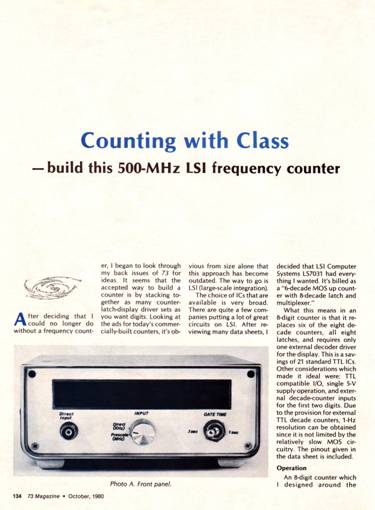
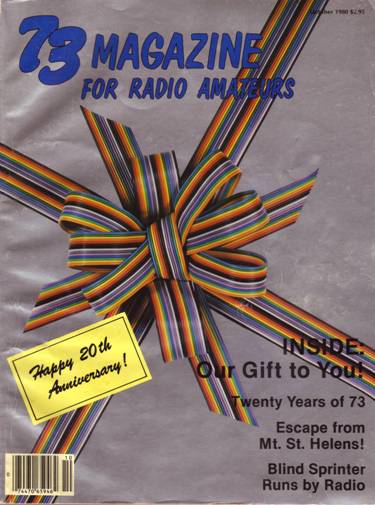
|
Article for “EDN Magazine” Oct. 25, 2007 edition |
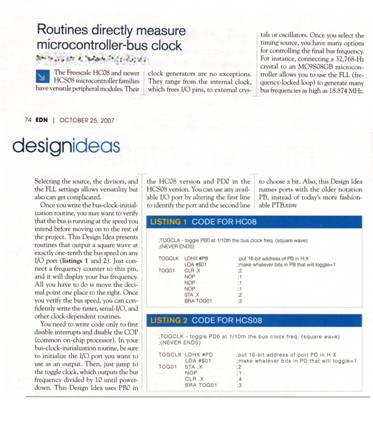
|
When reading engineering magazines I would see lots of Design Ideas which were µC based. However, very few were about Freescale (Motorola) processors. I decided to write a small article describing one of the routines from my bag of tricks that I use all the time. So, 27 years after my “73” article was published, “EDN” published my Design Idea in their Oct. 25, 2007 edition. |
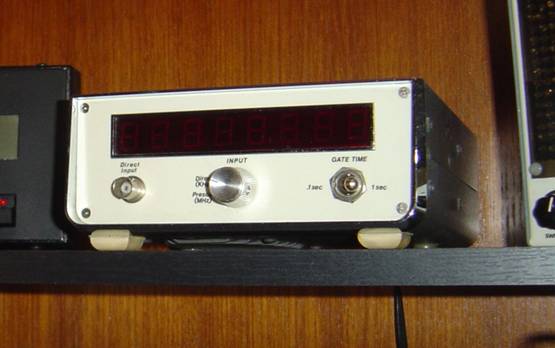

|
Eico “Electronic VOX” kit I built in the 8th grade |
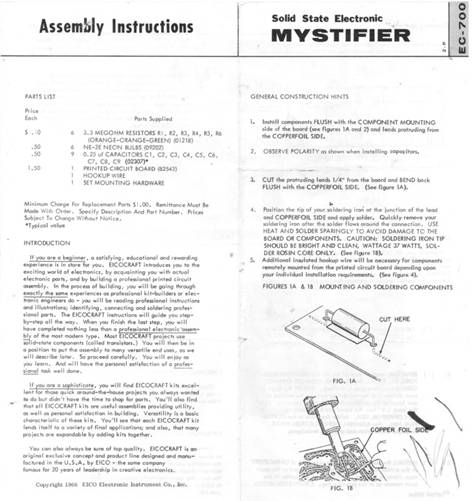
|
Actually, I had been experimenting with electricity/electronics for quite a while before this. But as I remember, it was in the 6th grade that I bought this Eico “Solid State Electronic Mystifier” kit at Tedco Electronics in Melbourne, FL. I remember assembling it and getting it working. It used a ridiculously expensive 90V battery!
I also remember putting longer wires on the neon bulbs so that I could spread them out and poke them through holes in a piece of pegboard which was about 10” square. I mounted the PCB on top next to the lamps and used 4 very long screws or possibly threaded shafts as legs, putting another square of pegboard as a lower level to hold the battery. I took it in for Show & Tell near the end of the school year. All the kids and the teacher were amazed as we watched it randomly flash all the neon bulbs.
OK, the craziest part of this story is that it’s now 48 years later and I still have the assembly manual in my files under “Opto”! |
|
Eico “Electronic Mystifier” kit I built in the 6th grade |
|
In the 8th grade there was going to be a Science Fair, and I think I had already started to build this kit. The Voice Operated Relay would look for loud sounds then trigger a relay with a timed release. I had it hooked to some kind of buzzer. Here I have the original manual and my Science Fair Project report. It sounds like I copied the circuit description from somewhere but it is not in the kit manual. I really don’t think I had that much insight into the circuit at that time but I can’t imagine who would have helped me. |
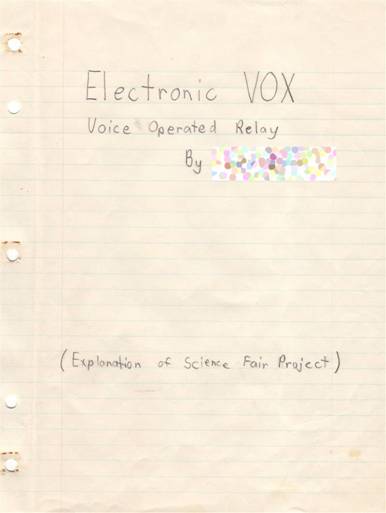
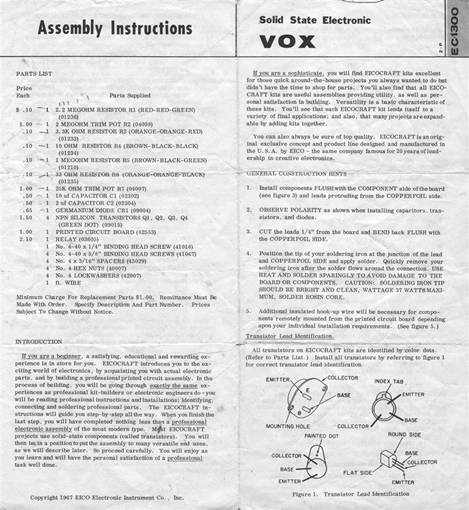
|
Article for “Design News Magazine” Nov 2016 edition |


|
I had created InkBot (see whole project in “Electronics & Maker Projects” pages of our website) to do a project which had servo motors & steppers. It was also a great project in that it was part 3D printing / mechanical and part electronics / software. When it was done and working, it occurred to me to submit it to Design News’ Gadget Freak. They responded saying how much they liked it, put it on their website and a few months later it was in print! |
|
Article for “Design News Magazine” July 2016 edition |


|
I had actually designed and built (see whole project in “Electronics & Maker Projects” pages) the Cat Food Dispenser before InkBot. When I was submitting InkBot to Design News, I mentioned my dispenser to the editors and they encouraged me to submit that too! So now I had two articles in the same magazine in the same year. |
|
Solid State Scope - Senior Project at FIT |
|
In my senior year at FIT we had to submit ideas for our Senior Project. My “Solid State Scope” was one of the concepts chosen, so I was made head of the “company”. FIT had a very theory / math / physics heavy curriculum. I, on the other hand, just loved electronics and would have preferred a more practical electronics design education. But you don’t turn down free, so it was off to FIT.
The net result was that I was a mediocre student at best, but since I had been designing and building electronics as my hobby for years, I was way ahead of the other guys in this respect. So, I designed and built the entire thing, and the other guys fulfilled some of the other class requirements for the group.
When I first proposed this idea, one of the professors took me into his office and said he liked the idea but there was no way I was going to be able to actually build something that worked. Given how little practical electronics we had been taught, it wasn’t hard to understand why he said this.
For example, in our first “lab” class, I walked in just before it started, and some of the guys were playing with LEDs. They said ‘what a cheap school, none of these LEDs are any good’. Well, I think this was our junior year and none of these guys knew you had to have a current limiting resistor in series with an LED. They were just putting them across a supply where they burned up before they could emit any light.
Anyway, designing the scope wasn’t that big a deal. However, building it by hand on Radio Shack breadboard with point-to-point wiring was an enormous task. Especially the LED matrix! I ended up buying my first quality Weller soldering station to use instead of the cheap irons I had always had. Not only that, I realized I had to design and build a power supply with built-in logic probe before beginning development.
It worked great, even though the LEDs in the day were very inefficient. I was a little worried it wouldn’t be bright enough for the final demonstration, but when we turned out the lights “to see it better” no one gave it a second thought. The professors were really impressed and they ended up keeping our final write-up, that’s why I don’t have it today.
|









|
Here it is 37 years later. |
|
Ham Radio 2M Repeater Controller |


|
I had been studying on and off for my Amateur Radio license before arriving at FIT for my freshman year. When I got there, I saw that they had a Ham Club. So I finished studying and got my morse code up to minimum and took the test. Sadly, the volunteer who gave me the test failed to get it in in time and long story short I had to wait about a year to actually get my license. It’s dated “11-28-75”. I had had CB radios and shortwave receivers for years, but what I was really interested in was the 2M FM band. After getting my license I had a series of 2M radios and in fact still have the one that I put in my Renault in 1978!
The great thing about 2M FM was repeaters. They let the relatively short range / crystal clear audio 2M transceivers cover a huge area by being located on towers or tall buildings. They receive on one frequency and transmit that audio on another simultaneously. Mobile radios transmit / receive on the opposite frequencies so everyone communicates through the tall antennas of the repeater. Not only that, but a repeater can have a “phone patch” to connect you to a phone line to make calls. |
|
This was years before cellphones. So, in the last year of school I designed and built a repeater controller. This was a couple years before the Apple II came out and before I got into microprocessors. I designed it with lots of analog and logic ICs. It had a touchtone decoder to activate functions such as the phone patch. I used a PROM to automatically send the ID in morse code every 5 min. as was required. Later, when I returned to Melbourne to work at Dictaphone, I improved the circuit including going to a crystal controlled DTMF receiver.
I rewired a trimline phone, putting in a real microphone, tiny speaker and a push to talk (PTT) button. I put a connector on it so that it would plug into the small somewhat portable Drake 2M transceiver I had at the time. I had the phones keypad backlight come on with a switch. It had a shoulder strap. So, I had a portable phone which I used through our repeater. Too much fun! |
|
The reason you need a PTT button is that ham transceivers, basically “walkie-talkies” can only transmit or receive, never both at the same time. This is called “simplex” unlike a phone or cellphone where both parties can hear each other all the time, known as “duplex”. So, in my last year at school, I put a UHF link on the repeater. Then, I incorporated a UHF receiver into my then current 2M system.
Now I had full duplex when I made a phone call and in that mode did not need to use the PTT button. I wish I had a picture, but for a while I had the whole repeater system up at the house. I had a Kawasaki on/off road motorcycle. I mounted radios in an enclosure along with an antenna for 2M and one for UHF and clamped the whole thing to the luggage rack. I mounted the trimline phone to the cross member of the handlbars. So, I could be out riding the trails, pull over and make a phone call. No big deal today, but back then people were amazed! |

|
After graduating from FIT in Aug. of 1979, I went home to recover and start looking for a job. While there, I designed and built a frequency counter.
When I was done I put it in an old Lafayette lo-band police receiver chassis I had laying around. It had a nice look so I thought why not write it up and submit it as an article for the ham radio magazine “73”. Even after they accepted it, it took almost a year to show up in print, landing in the Oct. 1980 edition. Below is the counter today, 35 years later, now in a curio cabinet.
|